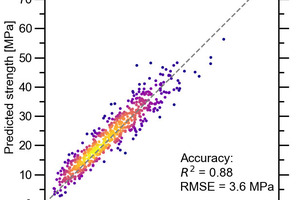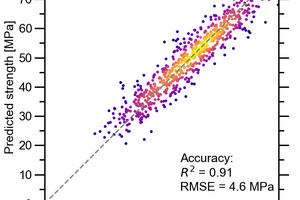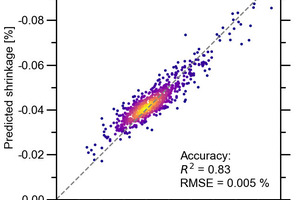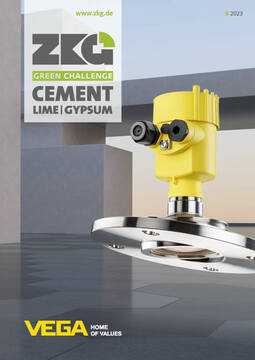REFERENCES
[1] Ali, M.B.; Saidur, R.; Hossain, M.S.: A review on emission analysis in cement industries. Renewable and Sustainable Energy Reviews 15 (2011) pp. 2252-2261; https://doi.org/10.1016/j.rser.2011.02.014
[2] Carbon neutrality by 2050: the world’s most urgent mission | United Nations Secretary-General, (n.d.); https://www.un.org/sg/en/content/sg/articles/2020-12-11/carbon-neutrality-2050-the-world%E2%80%99s-most-urgent-mission (accessed September 2, 2021)
[3] Khoury, G.A.; Majorana, C.E.; Pesavento, F.; Schrefler, B.A.: Modelling of heated concrete. Magazine of Concrete Research 54 (2002) pp. 77-101; https://doi.org/10.1680/macr.2002.54.2.77
[4] Breysse, D.; Martínez-Fernández, J.L.: Assessing concrete strength with rebound hammer: review of key issues and ideas for more reliable conclusions. Mater Struct. 47 (2014) pp. 1589-1604; https://doi.org/10.1617/s11527-013-0139-9
[5] Chou, J.-S.; Chiu, C.-K.; Farfoura, M.; Al-Taharwa, I.: Optimizing the Prediction Accuracy of Concrete Compressive Strength Based on a Comparison of Data-Mining Techniques. Journal of Computing in Civil Engineering 25 (2011) pp. 242-253; https://doi.org/10.1061/(ASCE)CP.1943-5487.0000088
[6] Chopra, P.; Sharma, R.K.; Kumar, M.; Chopra, T.: Comparison of Machine Learning Techniques for the Prediction of Compressive Strength of Concrete. Advances in Civil Engineering 2018 (2018) e5481705; https://doi.org/10.1155/2018/5481705
[7] Wild, S.; Sabir, B.B.; Khatib, J.M.: Factors influencing strength development of concrete containing silica fume. Cement and Concrete Research 25 (1995) pp. 1567-1580; https://doi.org/10.1016/0008-8846(95)00150-B
[8] Burris, L.E.; Alapati, P.; Moser, R.D.; Ley, M.T.; Berke, N.; Kurtis, K.E.: Alternative cementitious materials: Challenges and opportunities. In: International Workshop on Durability and Sustainability of Concrete Structures, Bologna/Italy, 2015
[9] Chou, J.-S.; Tsai, C.-F.; Pham, A.-D.; Lu, Y.-H.: Machine learning in concrete strength simulations: Multi-nation data analytics. Construction and Building Materials 73 (2014) pp. 771-780; https://doi.org/10.1016/j.conbuildmat.2014.09.054
[10] Gupta, S.M.: Support Vector Machines based Modelling of Concrete Strength, 3 (n.d.) 7
[11] Young, B.A.; Hall, A.; Pilon, L.; Gupta, P.; Sant, G.: Can the compressive strength of concrete be estimated from knowledge of the mixture proportions?: New insights from statistical analysis and machine learning methods. Cement and Concrete Research 115 (2019) pp. 379-388; https://doi.org/10.1016/j.cemconres.2018.09.006
[12] Oey, T.; Jones, S.; Bullard, J.W.; Sant, G.: Machine learning can predict setting behavior and strength evolution of hydrating cement systems. Journal of the American Ceramic Society 103 (2020) pp. 480-490; https://doi.org/10.1111/jace.16706
[13] Ouyang, B.; Song, Y.; Li, Y.; Wu, F.; Yu, H.; Wang, Y.; Yin, Z.; Luo, X.; Sant, G.; Bauchy, M.: Using machine learning to predict concrete’s strength: learning from small datasets. Eng. Res. Express 3 (2021) 015022; https://doi.org/10.1088/2631-8695/abe344
[14] Ouyang, B.; Song, Y.; Li, Y.; Wu, F.; Yu, H.; Wang, Y.; Sant, G.; Bauchy, M.: Predicting Concrete’s Strength by Machine Learning: Balance between Accuracy and Complexity of Algorithms. MJ 117 (2020) pp. 125-133; https://doi.org/10.14359/51728128
[15] Das, A.K.; Suthar, D.; Leung, C.K.Y.: Machine learning based crack mode classification from unlabeled acoustic emission waveform features. Cement and Concrete Research 121 (2019) pp.42-57; https://doi.org/10.1016/j.cemconres.2019.03.001
[16] Okazaki, Y.; Okazaki, S.; Asamoto, S.; Chun, P.: Applicability of machine learning to a crack model in concrete bridges. Computer-Aided Civil and Infrastructure Engineering 35 (2020) pp. 775-792; https://doi.org/10.1111/mice.12532
[17] Hoang, N.-D.; Chen, C.-T.; Liao, K.-W.: Prediction of chloride diffusion in cement mortar using Multi-Gene Genetic Programming and Multivariate Adaptive Regression Splines. Measurement 112 (2017) pp. 141-149; https://doi.org/10.1016/j.measurement.2017.08.031
[18] Cai, R.; Han, T.; Liao, W.; Huang, J.; Li, D.; Kumar, A.; Ma, H.: Prediction of surface chloride concentration of marine concrete using ensemble machine learning. Cement and Concrete Research 136 (2020) 106164; https://doi.org/10.1016/j.cemconres.2020.106164
[19] Bangaru, S.S.; Wang, C.; Hassan, M.; Jeon, H.W.; Ayiluri, T.: Estimation of the degree of hydration of concrete through automated machine learning based microstructure analysis – A study on effect of image magni-
fication. Advanced Engineering Informatics 42 (2019) 100975; https://doi.org/10.1016/j.aei.2019.
100975
fication. Advanced Engineering Informatics 42 (2019) 100975; https://doi.org/10.1016/j.aei.2019.
100975
[20] Song, Y.; Huang, Z.; Shen, C.; Shi, H.; Lange, D.A.: Deep learning-based automated image segmentation for concrete petrographic analysis. Cement and Concrete Research 135 (2020) 106118; https://doi.org/10.1016/j.cemconres.2020.106118
[21] Das, A.; Song, Y.; Mantellato, S.; Wangler, T.; Flatt, R.J.; Lange, D.A.: Influence of Pumping/Extrusion on the Air-Void System of 3D Printed Concrete. In: Bos, F.P.; Lucas, S.S.; Wolfs, R.J.M.; Salet, T.A.M. (Eds.): Second RILEM International Conference on Concrete and Digital Fabrication. Springer International Publishing, Cham, 2020: pp. 417-427; https://doi.org/10.1007/978-3-030-49916-7_43
[22] Hickman, M.: Concrete.ai releases tool reducing cost of concrete construction. The Architect’s Newspaper (2022); https://www.archpaper.com/2022/10/concrete-ai-releases-tool-reducing-cost-carbon-intensity-concrete-construction/ (accessed January 1, 2023)
[23] Zhenchao, D.: Discussion on Problem of Standard Deviation of Concrete Strength. MJ 117 (2020) pp. 25-35; https://doi.org/10.14359/51718053
[24] Standard Test Method for Slump of Hydraulic-Cement Concrete (n.d.); https://www.astm.org/c0143_c0143m-20.html (accessed August 28, 2022)
[25] Standard Test Method for Length Change of Hardened Hydraulic-Cement Mortar and Concrete (n.d.); https://www.astm.org/c0157_c0157m-17.html (accessed August 28, 2022)








